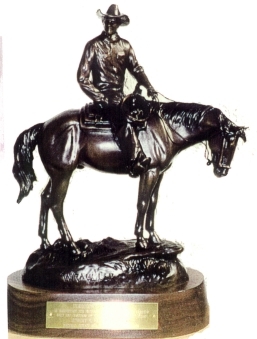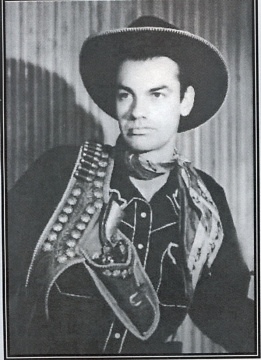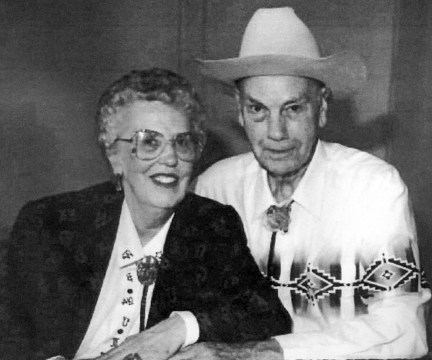[It is difficult to encapsulate the life of a man who has done so
many remarkable things. The following merely touches on the
highlights of that life as it affects the film industry.]
Of Irish descent, Robert E. Lee "Bob" Brown was born May
22, 1910 in Geneva, Indiana, the youngest of five children. Both his
father and uncle were oil drillers, a trade learned from their father.
When he was four years old, Bob's family went to Turner Valley,
Alberta, 20 miles outside the Canadian province's capital. His father
and uncle had been summoned to drill the first oil well in Canada,
and they succeeded in only a few months, at which time the Browns
returned to Indiana.
As work in their field dwindled in Indiana, Uncle Bob moved to Long
Beach, California, while his brother's family moved to Bluffton,
Indiana. But Bob's mother became tubercular and the doctor prescribed
a change in climate. So, in 1916 the family picked up stakes and
moved to Long Beach.
Even though the two brothers were often called away to drill for oil,
e.g. Alaska, the family stayed put and young Bob spent his childhood
in Long Beach. Later, the family moved to Monrovia where Bob attended
High School.
Bob's interest in art had begun when, as a child, he whittled his own
toys. This talent was enhanced at the Pasadena Junior College, where
he studied art with Archie Wedemeyer. But his 6' 4" frame also
got him on the College's baseball and basketball teams. In 1931, the
baseball team with Bob as pitcher won the state championship.
Unfortunately, his participation in basketball led to a serious
accident in which he severely injured his neck. In fact, when war
broke out, Bob was declared 4F because the doctors found that he had
completely shattered four vertebrae and the disks were herniated. As
a result, Bob suffered from severe headaches all his adult life.
In the summer of 1931, Bob was awarded a scholarship to the famous
Chouinard School of Art in Los Angeles. There he studied layouts,
lettering, and composition, etc. under "Tink" Adams. When
Adams had a falling out with the owner of the school, he quit to set
up his own school, inviting his best student to join him.
Bob lent him five dollars to help make up the first month's rent and
he painted the rooms that were to be used as the school, and when the
doors opened, Bob was the first of the eight students that made up
the student body that year. Other art teachers were recruited from
Pasadena's high schools.
The Art Center School of Design attracted much notice, mainly because
of its talented progenitor, and even art personnel from the movie
studios took lessons there. Lionel Banks, head of Columbia Pictures'
Art Department came over to learn about water colours, an area in
which Bob excelled. Adams had Bob teach him. Banks learned quickly,
and after seeing what the students were capable of, he told Adams
that his studio needed a new logo and suggested he hold a contest to
see what they could come up with. All the students took part, but Bob
won both first and second place.
His first place entry became the famous Lady with the Torch, and
Bob's version introduced Columbia's films from 1931 to 1941. The
model for the design was a an attractive blonde that had been posing
for the Life Class Bob was taking. He draped some cloth over her,
gave her a broomstick to hold up and from that he produced the
winning design. Bob still has the drawing of his second place entry.
Needless to say, neither Bob nor the model received any compensation
for the logo, but this exploitation was only the first of many
incidents that soured Bob on the movie industry.
In 1933, Bob became a commercial artist for Spielman and Conners in
the Bendex Building. While there, he designed logos for Max Factor
and packaging for Coca Cola. The headaches were worsening, probably
because his working area was too confining. And he quit a year later.
A few weeks after leaving his job as a commercial artist, Brownie was
out trying to walk off a severe migraine headache. He had walked from
Monrovia to Arcadia — a couple of miles. As he passed a shop on
125 North First Street, he stopped to watch a silversmith through the
window. It was Frankie Paul, and sensing the youth was very
interested in what he was doing, he invited him in. Brown informed
him he was a commercial artist. Paul told him that he needed an eagle
with its wings spread out as if in flight, and within five minutes
Bob drew him one. In gratitude, Paul made him a belt... and hired
him. This was to be the beginning of his career as a leather artist.
But Bob needed tools, and didn't have much money. In this connection,
Bob relates a story on the origin of his first tools.
Up the street from Frankie Paul's shop in Arcadia was the famous
Santa Anita Ranch owned by millionaire Lucky Baldwin, who had died in
a cottage on the property three years earlier. Bob needed some steel
rods to create his tools and he remembered the bed in which Baldwin
had died. So riding his horse over there one day, he went into the
cottage with a hacksaw and cut himself some steel rods. With these he
created his first leather tools.
In addition, Bob discovered that he had much greater success carving
leather with a converted screwdriver than with the traditional swivel
knife, so from that time on, that is all he used.
In 1936, he was almost signed by Paramount as an Art Director.
One of Bob's peripheral interests was law enforcement, and in 1936, he joined
the Los Angeles County Sheriff's Department as a Reserve Deputy Sheriff,
which meant that he worked unpaid.
In 1937, Frankie Paul moved his shop to Whittier, California, so Bob
set up shop on 5910 Hollywood Blvd. near the corner of Bronson Ave.,
renting window space from the Hollywood Boot Maker. One of his first
jobs was to create the tunic, belt, shoes and cap for Errol Flynn in The
Adventures of Robin Hood.
Having his own shop did not prevent him from working as a staff
artist for Brown and Bigelow, the world-famous calendar company.
Salesmen would come down to his shop with orders for leather
billfolds, key cases and desk sets. Norman Rockwell also worked for
the company, and would later confer on him the title of "the
Leonardo of Leather."
As a reserve deputy sheriff, Bob got some interesting assignments. He
acted as bodyguard for Madam Chiang Kai Shek when she was on a fund
raiser at the Hollywood Bowl, and for Chief Justice Earl Warren when
he came to Los Angeles to open the new Superior Courts Building.
After setting up shop on Hollywood Blvd., Bob met Juliana A.
Jacklett, better known as Jolly. She worked in Goddard's Cafe‚
near his shop. They were married on May 3, 1945 in Las Vegas, Nevada.
Later she worked in Paramount's Wardrobe Department, dressing the
likes of Barbara Stanwyck. The couple had two children, Kathie Ann
and Karen Lee.
By 1946 Bob had decided to set up shop closer to the studios for
which he did most of his work, Republic and Universal. His new shop
was located on Ventura Blvd, between the two studios. He stayed there
until 1948, then opened up the Range Busters Corral in North
Hollywood. That same year he was made an honorary Texas Ranger. But
the studios were never munificent in their wages to Bob, and by 1951,
he had had enough. So he moved back to Los Angeles, opening another
small shop on 7th Street, opposite the building that had housed the
first Art Center School of Design.
In 1952, the sheriff of Los Angeles County, Gene Biscailuz, persuaded
Bob to join the Sheriff's Department as a paid official instead of
unpaid reserve officer. Bob From that time on, all his leather craft
work was done in his home.
Bob remained with the Sheriff's Department until his retirement in
1970. He was the Psycho Ward Bailiff for a time, one of his famous
inmates being Bela Lugosi, who died in his presence. And his final
task was to escort Sirhan Sirhan to a court hearing.
After retiring, he and his wife Jolly moved to Big Bear City. His wife passed
away in 1997.
Among his closest friends were the late actor Robert Bray, outlaw Al
Jennings, and Norman Rockwell.
In April 2001, just a month prior to his 91st birthday, Bob was
inducted into the National Cowboy and Western Heritage Hall of Fame
in Oklahoma City.
In September 2005, Bob passed away peacefully at his home in Big Bear. He was 95
years old.
|
 |
This is the Western Heritage Wrangler Directors’ Award
presented to Bob by Dennis Weaver “for a special and
significant contribution to the image-making of Hollywood’s
western movie era.” From several accounts, Bob’s
acceptance speech
was the highlight of the affair. |
The following are some of Bob's Hollywood
clients and acquaintances and work that he completed for them
1. Richard Arlen - waist belt
2. Rex Allen - Sr- reverse
double holsters and belt
3. Lionel Barrymore - belt
and hatband
4. Ward Bond - horsehide
orthopedic legging for his mutilated leg
5. Beulah Bondi - handbag
6. Randy Boone - guitar strap
7. Robert Bray - numerous
items, including director's chair and rifle scabbard
8. Eddie Cantor - leather gloves
9. Leo Carrillo - silver
saddle (created with Frankie Paul)
10. Sue Carroll - sports belt
11. Sunset Carson - silver holster outfits
12. Montgomery Clift - first low
slung holster in Hollywood (for Red River), spur straps
13. Any Clyde - a new gun rig
14. Charles Coburn - billfold
15. Gary Cooper - holster outfit
(for The Plainsman)
16. Ray "Crash" Corrigan
- gunbelt, portrait of him for his car seat
17. Jeanne Crain - a script cover
with all her film titles
18. Hume Cronyn - script cover
19. Bing Crosby - carved picture
of “win - place - show” horse at the Santa Anita Race Track
20. Dick Curtis - billfold
21. Ken Curtis - belts
22. James Dean - carved belt with
silver buckle
23. Richard Dix - waist belts for
his twin boys
24. Albert Dekker - costumes for
his role as Bat Masterson
25. Jack Dempsey - hatband
26. Cecil B. DeMille - boot
straps, quirt (swagger stick)
27. James Ellison - his Buffalo
Bill outfit for The Plainsman
28. “Elsie”
the Cow - four carved shoes with blue bows for
Vaudeville “Orpheum Circuit”
29. Dale Evans - carved neck
collars with silver and gold spots
30. Glenda Farrell - Dance Hall garter
31. Tommy Farrell - his first
buscadero outfit at Monogram Studios
32. Evelyn Finley, Nellie Walker -
ladies' belts with names on back
33. Errol Flynn - green tunic,
shoes, quiver for The Adventures of Robin Hood. Bob
also lent Flynn his horse Don as Custer's mount in
They Died with Their
Boots On.
34. Paulette Goddard - grey
'suede' slippers
35. William S. Hart - portrait of
him hanging in the Hart Museum in Newhall
36. Jean Harlow - make-up bag
37. Raymond Hatton - gunbelt,
waist belt
38. Rock Hudson - western belt
39. Rex Ingram - recovered four
old chairs
40. Al Jennings - all his leather
gear; reworked his colt 45 to appear like the one he used in train holdups
41. Jennifer Jones - 4 pairs of sandals
42. Howard Keel - white latigo
holsters for Annie Get Your Gun.
43. Gene Kelly - put his first
double taps on his shoes for a test film when he first arrived in Hollywood
44. John King - gunbelt, waist belt
45. Alan 'Rocky' Lane - 2 gun rigs
46. Liberace - a guest book in the
shape of a piano
47. Elmo Lincoln (first screen
Tarzan) - orthopedic leggings for his varicose veins when he was elderly
48. Bob Livingstone - script book cover
49. Franchot Tone - makeup kit, wallet
50. Pierce Lyden - made his last
gunbelt in 1998
51. Jock Mahoney - tuaght him to
make his own costumes, including moccasins
52. Johnny MacBrown - gunbelt,
waist belt, etc.
53. Mike Mazurki - billfold, waist belt
54. Carmen Miranda - platform
shoes to add to her height
55. Bob Nolan (one of the Sons of
the Pioneers) - belts
56. Gregory Peck - gunbelt, chaps,
hat band
57. Tyrone Power - gauntlet gloves
58. Basil Rathbone & Nigel
Bruce - matching carved sandals
59. Rodd Redwing - taught him
leather work and how to make Indian costumes
60. Roy Rogers - waist belts, gun rigs
61. Gilbert Roland - wrsit bands
62. Cesar Romero - waist belt
63. Franklin D. Roosevelt -
“Remember Pearl Harbor” carving now hanging in Hyde Park
64. Randolph Scott - single and
double holsters, waist belts
65. Dinah Shore - corrective shoe heels
66. James Stewart - silver plate
on rifle for Winchester “73”, script cover
67. Robert Taylor - Roman tunics
for Quo Vadis, wrist bands
68. Max Terhune - script cover,
cowboy belt
69. Gene Tunney - wrist bands,
watch bands, wallet
70. Claire Trevor - historic
lady's handbag and belt
71. John Wayne - boot tops,
holster, belt
72. Earl Moser - leather gear for
the women warriors in Tarzan and the Amazons
73. Tex Williams - double X holsters
74. Chill Wills - belt with a
silver buckle
|
 |
 |
|
Bob Brown in 1943 |
Bob and wife
Jolly in 1996 after 51 years of marriage |
Use your BACK
button to return to the page on TARZAN
AND THE AMAZONS.


